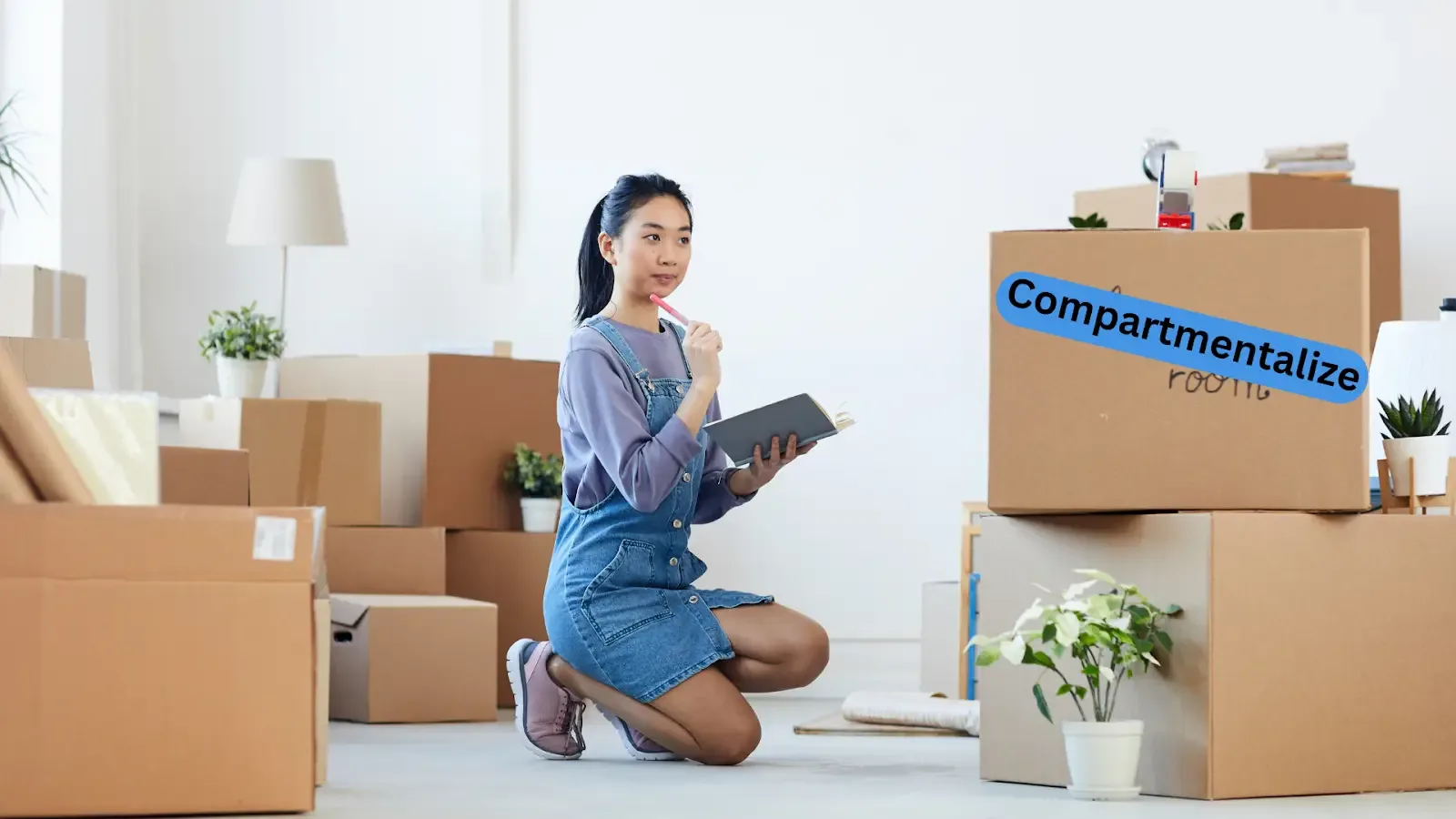
Let’s talk about how to compartmentalize, because sometimes, putting life into tidy little boxes is the only way to stay sane.
Whether it’s juggling work stress, relationship drama, or deciding what to eat for dinner (again), knowing how to compartmentalize is a skill everyone needs.
Not just for overachievers or secret agents, this is for you, me, and everyone who occasionally screams into their pillow.
Let me show you how to master the art of mental “box-stuffing” without becoming an emotional robot.
Ready?
Let’s do this.
What Is Compartmentalizing (and Why You Need It)?
Compartmentalizing is basically organizing your brain like a filing cabinet.
Work stress?
Drawer one.
Relationship drama?
Drawer two.
That argument you had with your toddler over socks?
Drawer… somewhere far, far away.
Think of it like this: Your brain is a suitcase.
When everything’s thrown in together, it’s chaos.
Compartmentalizing is like using packing cubes: you sort things, zip them up, and only open what you need when you need it.
It’s how you stay focused and avoid dragging your emotional baggage into every single moment.
Why should you care?
Because if you don’t compartmentalize, life feels like one giant, messy pile of laundry you can’t escape from.
And nobody needs that.
The Good, the Bad, and the “Oh No, Did I Just Compartmentalize Too Much?”
The Good:
Compartmentalizing is your secret weapon against overwhelm.
It lets you focus on what’s in front of you instead of drowning in everything at once.
For example, it keeps you from worrying about laundry while you’re trying to ace a work presentation.
Win-win.
It’s also great for protecting your relationships.
Instead of dragging your work stress home and turning dinner into a vent session (we’ve all been there), you can park it in a mental box.
Your partner doesn’t need to hear about Janet from accounting every single night.
Another perk?
Compartmentalizing keeps you from spiraling.
You can set worries aside and revisit them when you’re in a better headspace.
Like, “I’ll deal with that awkward text from my friend tomorrow, today, I’m binge-watching The Office.”
And don’t forget self-care!
Compartmentalizing guilt (yes, moms, I’m talking to you!) into its own little box means you can finally enjoy some “me time” without feeling like the worst person ever.
Spoiler: You’re not.
The Bad:
Compartmentalizing can go wrong if you overdo it.
Sure, you’re avoiding stress now, but if you stuff too many feelings into too many boxes, they’ll eventually explode.
Think of it like shoving junk into a closet: eventually, the door won’t close, and everything comes tumbling out at the worst possible time.
Hello, ugly cry at the grocery store.
Also, compartmentalizing too much can make you seem… cold.
If you’re so good at locking up emotions that you never share them, people might think you don’t care.
Spoiler: That’s not good for relationships.
Your partner or bestie needs to know what’s in those boxes occasionally.
One more downside?
Compartmentalizing can make you procrastinate on dealing with the hard stuff.
Like when you tell yourself, “I’ll think about my finances later,” and six months later, you’re dodging calls from your bank.
Compartmentalizing is a tool, not a permanent hiding place.
The “Oh No”:
Here’s where things get tricky: Over-compartmentalizing can make you lose sight of what’s really important.
You get so good at separating work, family, and emotions that you forget they’re all connected.
Like, what’s the point of nailing your to-do list if you’re too emotionally shut off to enjoy the wins?
And then there’s the “forgotten box” problem.
You file away something important, like your feelings about a big fight or a major decision, and leave it there too long.
When it finally resurfaces, it’s bigger, scarier, and messier than before.
It’s like leaving leftovers in the fridge for way too long. Gross.
Classic example?
Ross from Friends. His “We were on a break!” meltdown was a prime case of over-compartmentalizing.
He filed away his emotions so neatly that when they finally spilled out, they created a disaster.
Learn from Ross.
Don’t be a Ross.
So, while compartmentalizing is an amazing tool, don’t let it turn you into a feelings-stuffing machine.
Balance is key!
Know when to open those boxes and deal with what’s inside.
Trust me, it’ll save you from an emotional landslide (or a Ross moment).
How to Compartmentalize Without Losing Your Mind
Label Your Mental Boxes
Think of your brain as a neatly organized pantry (or at least the pantry you wish you had).
Each “box” should have a clear label.
Work drama?
Goes in the “Don’t think about it after 6 p.m.” box.
Family arguments?
Park them in the “Address when everyone’s calm” box.
Cravings for dessert?
Honestly, leave those in every single box, they deserve it.
Pro tip: Get creative with your mental labels.
Name them something funny or empowering, like “Karen’s Complaints” for that coworker who won’t stop whining or “Guilt-Free Zone” for when you just need to relax.
It’ll make compartmentalizing less intimidating and more fun.
Set Boundaries (and Actually Stick to Them)
Boundaries are your best friend when learning to compartmentalize!
They’re like the little “Do Not Disturb” signs for your brain.
Work emails after hours?
Nope.
Family drama invading your workout time?
Not today.
The trick is to enforce them.
Think of boundaries as the locks on your mental boxes, they keep unwanted intrusions out.
Struggling to stick to your boundaries?
Use visual cues or routines.
For example, when you shut your laptop for the day, physically say, “Work is done.” (Yes, out loud… it’s weirdly satisfying.)
Or change into comfy clothes to signal that it’s “me time.”
Boundaries don’t just exist, they’re reinforced by habits.
Practice Switching Gears
Transitioning from one mental box to another can be tricky, but it’s essential for good compartmentalizing.
Think of it like shifting gears in a car, smooth transitions keep you moving without stalling.
Rituals are the secret sauce here.
Finish your workday with a quick walk, stretch, or jam session to your favorite hype song.
After a fight with your partner, do something calming before moving on, deep breathing, a funny TikTok, or snuggling your baby (bonus points if they smell like baby lotion).
These little routines help your brain close one box and open the next.
Use Time Blocks to Focus
One of the best ways to compartmentalize is to dedicate specific blocks of time to specific tasks.
For example, give yourself one hour to respond to emails, then move on to playtime with the baby, and later focus on relationship time with your partner.
Here’s the catch: During each block, you commit only to that task.
No scrolling Instagram while brainstorming work ideas.
No planning dinner during baby time.
Single-tasking is your best friend when it comes to compartmentalizing!
Create a Mental Parking Lot
Sometimes, things creep into your mind when you don’t want them to, like remembering a forgotten bill while you’re trying to enjoy date night.
Instead of panicking, create a “mental parking lot.”
This is where you jot down (mentally or literally) things to revisit later.
Example: If you’re trying to focus on family time but remember a work task, write it down on a sticky note or a notes app.
Boom! Your brain is free to stay present without forgetting what needs attention later.
Learn to Let Go of Perfection
Let’s be real, your mental boxes aren’t going to be perfect all the time.
Some emotions will spill over, and that’s okay.
Compartmentalizing isn’t about being a robot.
It’s about managing your energy and focus.
If one box feels like it’s overflowing, address it, deal with it, and then move on.
Fun mantra: “It’s okay to have messy boxes. I’m human, not a perfectly organized spreadsheet.”
Use Visual or Physical Cues
If you’re a visual learner, create a tangible representation of your mental compartments.
For instance, some people swear by journaling, where each “box” gets its own section, like work notes, family reflections, and personal goals.
Others use apps or even color-coded planners.
Physical cues can also help.
Changing locations (e.g., leaving your home office for the living room) is a powerful way to mentally switch boxes.
Even small changes, like putting on headphones, lighting a candle, or brewing tea, can signal that you’re moving to a new compartment.
Allow Time for Emotions
Compartmentalizing isn’t about suppressing feelings, it’s about choosing when to deal with them.
Set aside time to open those emotional boxes when it’s safe and productive.
For example, if something upset you at work, wait until you’re calm at home to process it.
If you avoid opening those boxes, they’ll eventually explode (and nobody wants that).
Think of it as scheduled maintenance for your mental health.
Celebrate the Little Wins
When you successfully compartmentalize, celebrate it!
Maybe you kept work stress from invading date night, or you stopped obsessing about that awkward text.
Recognize your progress, even if it’s small.
Positive reinforcement helps make compartmentalizing a habit.
Compartmentalizing doesn’t mean shoving emotions into a dark corner and locking the door.
It’s about organizing your mental energy, setting boundaries, and giving yourself the freedom to focus on one thing at a time.
It might feel tricky at first, but with practice (and maybe a few sticky notes), you’ll get the hang of it—and your brain will thank you.

Secret Strategies Nobody Talks About
Let’s dive into the juicy strategies that don’t usually make the Pinterest-perfect blog lists.
These hacks are for when life gets messy, and you need to compartmentalize like a ninja.
You know those moments when someone says something so awkward or annoying that it lingers in your brain for hours?
Like when your mother-in-law “helpfully” suggests you try a new parenting book, or when your partner “forgets” to pick up milk for the third time this week.
Instead of reacting in the moment, file it away in your “Not Now” box.
This mental trick gives you space to cool off and think clearly.
Later, when you revisit the situation, you can handle it without passive-aggressive remarks (or a meltdown).
Pro tip: Pair this with the “mirror rule.”
Before responding, ask yourself, “Would I want this said to me in the same tone?”
If not, leave it in the box for now.
Micro-Compartmentalizing
Sometimes, big stressors feel impossible to deal with, like “my life is falling apart” level stress.
The trick?
Break the problem into smaller, more manageable chunks.
Instead of thinking, “Everything is a disaster,” focus on what you can fix right now.
Start with the tiniest piece of the puzzle.
For example:
“My house is a mess” → “Let me just do the dishes.”
“I can’t figure out my career” → “What’s one job posting I can research today?”
Micro-compartmentalizing takes the weight off your shoulders and makes life less overwhelming.
Plus, it gives you quick wins to boost your confidence.
The 90-Second Rule
Here’s a neuroscience nugget nobody tells you: Emotions only last about 90 seconds unless you feed them.
So, the next time rage, panic, or embarrassment hits, pause.
Count to 90.
Let the feeling wash over you like a wave, and let it go.
You’d be surprised how much calmer you’ll feel afterward.
This works wonders for those “Why did I say that?” moments or random waves of self-doubt.
Instead of stewing in the emotion all day, acknowledge it, ride it out, and move on.
Bonus: This technique saves you from sending that angry text you’ll regret later.
The “Emergency Shut-Down” Box
Sometimes, life throws you a curveball so big that you can’t process it all at once.
Enter the emergency shut-down box.
This mental compartment is for situations that are too overwhelming to handle right now.
It’s like hitting the “pause” button on your emotions.
Here’s the key: Use this sparingly.
It’s not for avoiding your problems forever, it’s for giving yourself the time and space to come back when you’re ready.
For example, if you’re having a bad day but need to stay professional for a big meeting, file your emotions in the emergency box.
Once the meeting’s over, open the box and process everything.
The “Two-Minute Box Rule”
Have you ever gotten stuck obsessing over a tiny issue?
Like rethinking that one comment you made at brunch?
Use the two-minute box rule.
Here’s how it works:
- Give yourself two minutes to think about it.
- When the timer’s up, force yourself to move on.
- If it pops back into your head, remind yourself, “I already gave this two minutes, it’s done.”
This technique is like Marie Kondo-ing your thoughts. If it’s not serving you, let it go.
Body-First Compartmentalizing
Your brain and body are connected, and sometimes, your brain won’t let go of something until your body feels better.
For those moments when you can’t mentally shake a problem, do something physical to signal to your brain, “Hey, we’re moving on now.”
Ideas:
- Go for a quick walk (even if it’s just to the mailbox).
- Stretch or do five minutes of yoga.
- Clap your hands and say, “Done!” (Yes, it feels silly, but it works.)
- This strategy is great for when your thoughts feel stuck on repeat, and you need a physical “reset” button.
Create a “Feel-Good” Box
Not all compartments are for dealing with stress.
Create a mental (or physical) box filled with things that bring you instant joy.
This could be your go-to playlist, funny memes, or a list of compliments people have given you.
When life feels heavy, open the “feel-good” box and dive into it guilt-free.
It’s like a mental spa day, and sometimes, that’s all you need to recharge.
Visualize the Box Being Closed
When you’re done compartmentalizing, mentally visualize closing the box and locking it up.
Picture a lid snapping shut or a vault sealing tight.
This simple mental trick signals to your brain that it’s time to move on.
Bonus points if you pair it with a small physical gesture, like clapping your hands or snapping your fingers.
Revisit the “Forgotten Boxes” on Your Terms
Not all boxes should stay closed forever.
Schedule time to check in on things you’ve parked for later.
This could be journaling once a week or setting aside an hour to tackle lingering emotional clutter.
Think of it as spring cleaning for your mind, keeping your compartments fresh and functional.
These secret strategies can take your compartmentalizing game to the next level.
They’re not about avoiding life’s chaos. They’re about managing it like a boss.
Now go forth and compartmentalize, you’ve got this!
How Compartmentalizing Can Improve Your Relationships
Compartmentalizing isn’t just a tool for managing stress.
It’s the ultimate relationship life hack.
Seriously, this skill can transform your connection with your partner, your friends, and even the family members who insist on sending unsolicited advice.
Done right, it keeps your relationships smoother, happier, and dramatically less dramatic.
Think of it as a way to keep your emotional baggage in the overhead compartment, close enough to handle but not spilling all over the aisle.
Take date night, for example.
Nothing kills the mood faster than bringing work stress to the table.
Instead of lovingly gazing into your partner’s eyes, you’re unloading about that email from your boss that made you question your entire career.
Romantic, right?
Compartmentalizing lets you mentally park your work worries before you sit down to dinner.
You can even turn the transition into a fun pre-date ritual, singing loudly in the car, swapping your work-from-home sweats for something cute, or dramatically announcing, “I now declare myself out of office!”
Trust me, your partner will thank you for it.
And then there are fights.
Fights happen because, well, relationships are between two flawed humans, and sometimes you’re both just hangry.
But do fights have to turn into epic sagas where every grievance from the past ten years gets dragged out?
Nope.
Compartmentalizing helps you focus on this issue without dumping every emotional file you’ve been hoarding.
When things get heated, mentally pause, box up unrelated frustrations, and deal with the actual problem.
If that sounds impossible in the moment, take a break.
Say, “Let’s cool off and talk later,” and come back when you’ve both moved out of angry-monster mode.
Compartmentalizing also stops you from playing emotional dodgeball with your partner.
You know the game, one minute you’re laughing about last weekend’s barbecue, and the next you’re snapping about a forgotten anniversary gift from six months ago.
Yikes.
By keeping emotions in their proper “boxes,” you save your partner from emotional whiplash and prevent those awkward “What just happened?” moments.
It’s all about timing.
Your partner will be much more open to discussing something important when they’re not already drowning in their own stress.
But here’s the thing: Compartmentalizing isn’t just about boxing up stress, it’s about creating space to enjoy the good stuff.
When you stop letting your work, personal worries, and everything else bleed into your time together, you’re free to focus on what really matters: connecting, laughing, and being present.
It’s not about ignoring emotions.
It’s about managing them in a way that protects your relationship.
And honestly, who doesn’t need a little extra mental organization in their life?
Conclusion
Compartmentalizing is an amazing tool to manage your emotions and focus on what really matters in your relationships.
It helps you stay present, avoid unnecessary conflict, and strengthen your connection with your partner.
But even the best compartmentalizing skills need a little boost sometimes and that’s where great communication comes in.
The Better Topics Card Game for Couples is the perfect tool to improve communication, bond with your partner, and keep things playful.
With repeatable questions designed to spark meaningful conversations, you can replay it endlessly, making it a fun and ongoing way to stay connected.
Whether you’re talking about dreams, goals, or just having a laugh, this game helps you create moments that matter.
So why not give it a try?
Grab the Better Topics Card Game, sit down with your significant other, and start building better communication and stronger bonds one question at a time.
Because staying connected isn’t just about compartmentalizing.
It’s about making time to grow, laugh, and love together.










